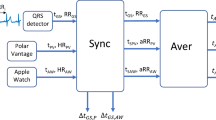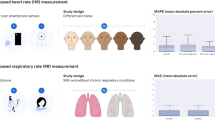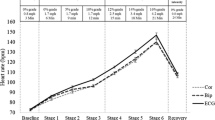Abstract
Photoplethysmographic imaging (PPG) is currently used to measure heart rate (HR) and the accuracy of PPG can be influenced by pigmentation of the skin; however, the effects of skin color-related artifacts on PPG during exercise remain unclear. This study aimed to assess the agreement between the Apple Watch photoplethysmography sensor and a criterion, for measuring heart rate across a range of intensities during exercise and to determine the influence of skin type on the accuracy of the measure. Forty-five males (20–43 y) completed the Fitzpatrick Skin Scale and were classified into three different skin type groups: a) types II (n = 15), III (n = 15) and IV (n = 15). Participants performed a graded incremental cycle-ergometer test while simultaneously wearing the Apple Watch and a Polar monitor as a criterion measure. Data from both devices were collected in 5-s epochs. Correlations between devices were very good (0.96–0.99 [95%CI: 0.94 to 0.99]). Significant differences were observed between skin types II and III when the intensity of the exercise was increased, albeit with trivial to small effect sizes (ES: 0.05 to 0.28). All significant differences corresponded to <2% of relative difference between both devices. Bland-Altman analyses showed a trivial but systematic underestimation of HR in the Apple Watch compared to Polar for all skin types during exercise. In conclusion, the Apple Watch accurately measures HR when cycling at different intensities and certain types of skin seem not to influence these measures, which may have important implications for controlling the intensity of exercise.



Similar content being viewed by others
References
Giles, D., Draper, N., and Neil, W., Validity of the polar V800 heart rate monitor to measure RR intervals at rest. Eur J Appl Physiol 116(3):563–571, 2016. https://doi.org/10.1007/s00421-015-3303-9.
Barbosa, M. P., da Silva, N. T., de Azevedo, F. M., Pastre, C. M., and Vanderlei, L. C., Comparison of polar® RS800G3™ heart rate monitor with polar® S810i™ and electrocardiogram to obtain the series of RR intervals and analysis of heart rate variability at rest. Clin Physiol Funct Imaging 36(2):112–117, 2016. https://doi.org/10.1111/cpf.12203.
Maeda, Y., Sekine, M., and Tamura, T., Relationship between measurement site and motion artifacts in wearable reflected photoplethysmography. J Med Syst 35(5):969–976, 2011. https://doi.org/10.1007/s10916-010-9505-0.
Spierer, D. K., Rosen, Z., Litman, L. L., and Fujii, K., Validation of photoplethysmography as a method to detect heart rate during rest and exercise. J Med Eng Technol 39(5):264–271, 2015. https://doi.org/10.3109/03091902.2015.1047536.
Stahl, S. E., An, H. S., Dinkel, D. M., Noble, J. M., and Lee, J. M., How accurate are the wrist-based heart rate monitors during walking and running activities? Are they accurate enough? BMJ Open Sport Exerc Med 2(1):e000106, 2016.
Madhan Mohan, P., Nagarajan, V., and Vignesh, J. C., Spot measurement of heart rate based on morphology of PhotoPlethysmoGraphic (PPG) signals. J Med Eng Technol 41(2):87–96, 2017.
Zhu, S., Tan, K., Zhang, X., Liu, Z., and Liu, B., MICROST: A mixed approach for heart rate monitoring during intensive physical exercise using wrist-type PPG signals. Conf Proc IEEE Eng Med Biol Soc:2347–2350, 2015. https://doi.org/10.1109/EMBC.2015.7318864.
Jo, E., Lewis, K., Directo, D., Kim, M. J., and Dolezal, B. A., Validation of biofeedback wearables for Photoplethysmographic heart rate tracking. J Sports Sci Med 15(3):540–547, 2016.
Allen, J., Photoplethysmography and its application in clinical physiological measurement. Physiol Meas 28(3):R1–R39, 2007.
Butler, M. J., Crowe, J. A., Hayes-Gill, B. R., and Rodmell, P. I., Motion limitations of non-contact photoplethysmography due to the optical and topological properties of skin. Physiol Meas 37(5):N27–N37, 2016. https://doi.org/10.1088/0967-3334/37/5/N27.
Fallow, B. A., Tarumi, T., and Tanaka, H., Influence of skin type and wavelength on light wave reflectance. J Clin Monit Comput 27(3):313–317, 2013. https://doi.org/10.1007/s10877-013-9436-7.
Fitzpatrick, T. B., The validity and practicality of sun-reactive skin types I through VI. Arch Dermatol 124(6):869–871, 1988.
Hopkins, W. G., Marshall, S. W., Batterham, A. M., and Hanin, J., Progressive statistics for studies in sports medicine and exercise science. Med Sci Sports Exerc 41(1):3–13, 2009. https://doi.org/10.1249/MSS.0b013e31818cb278.
Hopkins, W. G. Validity thresholds and error rates for test measures used to assess individuals. In Proc. 21st Annu. Congress of the European College of Sport Science, Vienna, Austria, 2016.
Bland, J. M., and Altman, D. G., Agreement between methods of measurement with multiple observations per individual. J Biopharm Stat 17(4):571–582, 2007.
Zou, G. Y., Confidence interval estimation for the Bland-Altman limits of agreement with multiple observations per individual. Stat Methods Med Res 22(6):630–642, 2013. https://doi.org/10.1177/0962280211402548.
Atkinson, G., and Nevill, A. M., Statistical methods for assessing measurement error (reliability) in variables relevant to sports medicine. Sports Med 26(4):217–238, 1998.
Dooley, E. E., Golaszewski, N. M., and Bartholomew, J. B., Estimating accuracy at exercise intensities: A comparative study of self-monitoring heart rate and physical activity wearable devices. JMIR Mhealth Uhealth 5(3):e34, 2017. https://doi.org/10.2196/mhealth.7043.
Khushhal, A., Nichols, S., Evans, W. et al., Validity and reliability of the apple watch for measuring heart rate during exercise. Sports Med Int Open 1(6):E206–EE11, 2017. https://doi.org/10.1055/s-0043-120195.
Wallen, M. P., Gomersall, S. R., Keating, S. E., Wisløff, U., and Coombes, J. S., Accuracy of heart rate watches: Implications for weight management. PLoS One 11(5):e0154420, 2016. https://doi.org/10.1371/journal.pone.0154420.
Shcherbina, A., Mattsson, C. M., Waggott, D. et al., Accuracy in wrist-worn, sensor-based measurements of heart rate and energy expenditure in a diverse cohort. J Pers Med 7(2), 2017. https://doi.org/10.3390/jpm7020003.
Lee, C. M., and Gorelick, M., Validity of the Smarthealth watch to measuring heart rate during rest and activity. Meas Phys Educ Exerc Sci 15(1):18–25, 2011.
Kamshilin, A. A., Mamontov, O. V., Koval, V. T., Zayats, G. A., and Romashko, R. V., Influence of a skin status on the light interaction with dermis. Biomed Opt Express 6(11):4326–4334, 2015. https://doi.org/10.1364/BOE.6.004326.
Author information
Authors and Affiliations
Corresponding author
Ethics declarations
Conflict of interest
Authors declare that there are no conflicts of interest.
Ethical approval
All procedures performed in studies involving human participants were in accordance with the ethical standards of the institutional and with the 1964 Helsinki declaration and its later amendments or comparable ethical standards.
Informed consent
Informed consent was obtained from all individual participants included in the study.
Additional information
Publisher’s Note
Springer Nature remains neutral with regard to jurisdictional claims in published maps and institutional affiliations.
This article is part of the Topical Collection on Mobile & Wireless Health
Rights and permissions
About this article
Cite this article
Sañudo, B., De Hoyo, M., Muñoz-López, A. et al. Pilot Study Assessing the Influence of Skin Type on the Heart Rate Measurements Obtained by Photoplethysmography with the Apple Watch. J Med Syst 43, 195 (2019). https://doi.org/10.1007/s10916-019-1325-2
Received:
Accepted:
Published:
DOI: https://doi.org/10.1007/s10916-019-1325-2




